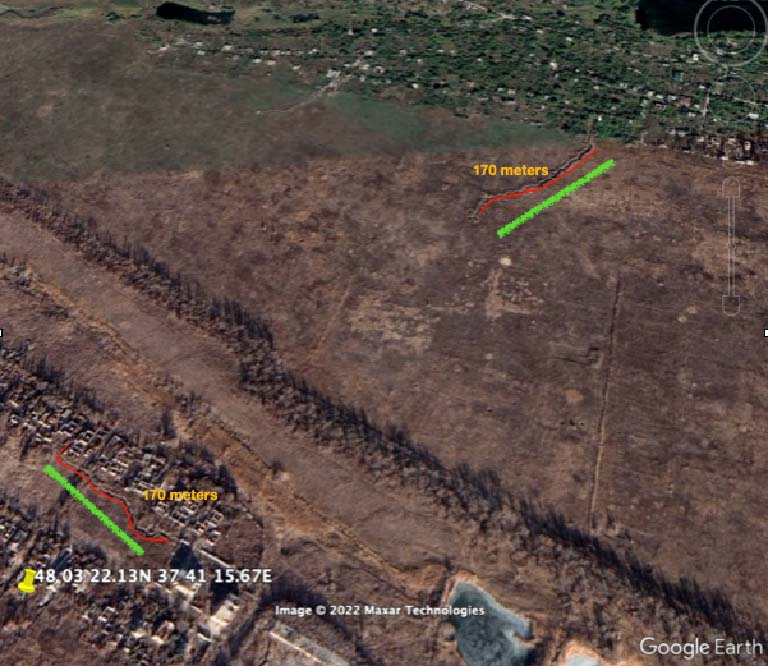The Ukrainian army is preparing for a counter-offensive to recapture Donbas and Crimea, which are currently occupied by Russian forces. Ukraine has raised eight ‘storm brigades” specifically for the counterattack. President Zelensky is determined to retake all the territory occupied by Russia and is overseeing the preparation of the upcoming counter-offensive, which can begin at any moment.
Despite advances in technology, trenches continue to be an important part of defensive strategy.
Western countries have supplied Ukraine with cutting-edge military equipment such as tanks, drones, long-range missiles, infantry fighting vehicles etc. They have also trained thousands of Ukrainian armed forces in advanced combat operations. However, given the nature of the battle, which is mostly fought in trenches, the Russian forces were able to keep off Ukrainian counter-attacks in most parts of the frontline. Despite the fact that Russia suffered severe losses, the frontline remained largely unchanged.
Fearing the counter-offensive, Russia has built a robust defense structure in the Donbas and Crimea regions. These trenches, located in areas under Russian occupation, serve as both defensive positions and helped in the transportation of troops and injured soldiers without being targeted by Ukraine’s artillery. The satellite image shows Russia has built 45-mile-long trenches on the outskirts of the village of Semenivka to a field outside the village of Marynivka.
The Washington Post reported that Russia constructed trenches spanning 20 miles along the western coastline of Crimea. Satellite images reveal that these fortifications were intended to protect against any seabound attacks from Ukraine. Along with trenches, Russia erected piles of dragon’s teeth – Pyramidal antitank bollards, minefields, pillboxes and tank traps to slow the Ukrainian advances. Trenches, which were originally used in World War, are still effectively used in modern warfare.
Despite advances in technology, trenches continue to be an important part of defensive strategy. According to Steve Danner, a US Army veteran and expert in trench warfare systems, breaching Crimea fortifications would require significant time, effort, and specialised equipment. Therefore, it is important to understand how Ukraine is planning to overcome the challenges posed by Russian trenches.
The recently established Ukrainian “storm brigade” will primarily have to focus on breaking through trenches and obstacles while ensuring the safe passage of friendly troops to move forward.
Even though Ukraine will be fighting with the most advanced Western tanks and infantry fighting vehicles, fighting through the web of trenches and obstacles in the Donbas would be challenging for Kyiv. According to Colonel Asada, an armor officer in the US Army, breaching is the toughest task a military force can face. He points out that the “complex obstacles” are designed to weaken the enemy’s fighting capability.
Moreover, “depending on the scope and location of the obstacles and how they are defended, the enemy hopes to force high casualties on the assault force or completely defeat the breach attempt,” says Colonel Asada. Therefore, the success of the Ukrainian armed forces in breaching the enemy’s position depends on their skills, training, and techniques because every trench and obstacle they encounter can be unique and different from others.
The recently established Ukrainian “storm brigade” will primarily have to focus on breaking through trenches and obstacles while ensuring the safe passage of friendly troops to move forward. Although Ukrainian forces may try to navigate around certain areas, they will inevitably encounter trenches at some point. Therefore, the role of combat engineers is crucial in this counter-offensive operations. Canada has deployed 40 combat engineers to Poland to train Ukrainian sappers on engineer reconnaissance, explosives, mining and de-mining. Ukraine also received a significant number of combat engineering vehicles and equipment from several countries, including Australia, America, Britain, Canada, Denmark, France, Germany, the Netherlands, Norway, and Slovakia.
If Russian defence can slow down the pace of the war and turn it into a prolonged conflict, Ukraine’s offensive will not only lose momentum but also be unsuccessful in recapturing its territory from Russian occupation.
In the recent aid packages, the US has included 32 recovery vehicles and 22 wheeled wreckers for winching and towing stuck and damaged tanks. Reportedly Ukraine has captured 200 specialist vehicles and three BAT–2s from the Russian forces. In total, Ukraine has a good number of combat engineering vehicles and equipment, including Germany’s Dachs, the American Assault Breachers, Norwegian NM189 Ingeniørpanservogn and Russia’s BAT-2, which gives Ukrainian sappers fighting chances in the trenches.
These engineering equipment are the most crucial to the success of a counter-offensive. Breaching trenches and obstacles will require combined-arms operations as the infantry, tank, and engineers need to work together. In 2022, Ukraine successfully recaptured Kherson during an autumn offensive, causing disarray among Russian soldiers. However, the Russian forces have been preparing for a prolonged conflict since then. If Russian defence can slow down the pace of the war and turn it into a prolonged conflict, Ukraine’s offensive will not only lose momentum but also be unsuccessful in recapturing its territory from Russian occupation.
Moreover, if Ukraine fails to make any significant progress in the counter-offensive, it will also lose international support for its war effort. Therefore, the success of the counter-offensive operations hinges on the Ukrainian armed force’s ability to breach Russian fortification in the Donbas region.
A successful counter-offensive by Ukraine has the potential to decisively turn the tide of the war. At the same time, Ukraine needs to prioritise conserving resources, training new recruits, and acquiring more tanks and infantry fighting vehicles to compensate for their losses on the battlefield.





